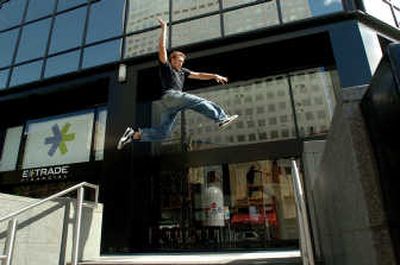Learning to fly

The opening sequence of “Casino Royale,” in true Bond fashion, is an intense chase scene, but this time the chase doesn’t include any high-tech gadgets or mega-buck cars. It’s just a couple of dudes running, jumping and pretty much getting themselves into situations that viewers assume have been digitally enhanced.
But the two stuntmen they have running in the scene are two of the world’s top participants in a sport called parkour.
Originally developed in France, the oddly-named sport was created by David Belle, drawing inspiration from several sources, including the efficiency of movement and training philosophy practiced by French soldiers in Vietnam, called Parcours de Combattant.
Belle, as well as the ever-growing base of participants in the sport, draw inspiration from other aspects of movement, such as gymnastics, martial arts and many other formsof physical activity to help their skills progress.
While the public façade of parkour involves stomach-churning leaps from rooftop to rooftop or Bond-style chases around construction sites, the sport is mainly a ground-based activity. Many advanced moves in the sport are derived from rudimentary skills that are learned and perfected at low altitude and then modified and applied to bigger, riskier situations for the benefit of the cameras and film crews.
The nuts and bolts of what is required to be an effective traceur (parkour-speak for a participant) depend on the individual, but most progress in the sport is made by developing jumping and landing techniques in order to bypass obstacles and absorb the energy of a long fall or a great deal of speed. To do this, participants integrate a roll into many landings in order to take the impact away from their joints and spine and turn it into forward motion.
Perhaps the most important element touted by the sport’s originators is the mind. In order to efficiently navigate seemingly impossible obstacles at high speeds, traceurs must know their skills to the point that they can envision exactly how they will navigate their way before they try it. Some even say that the sport’s philosophy of being able to overcome obstacles using only your body and some rudimentary skills can translate to other aspects of life.
The Internet seems to be the bastion of all things parkour. How-to instructions and videos abound, forums discuss the pros and cons of allowing a competition aspect in parkour, and mind-blowing videos litter YouTube to inspire participants and drop the jaws of mere mortals.
In order to get started in parkour, all you need is a good pair of running shoes, a light T-shirt, light pants or shorts and some stretchable undies. Some people like to use gloves for practice and protection, but emphasis is put on ease of movement.
As for conditioning, flexibility and an adventurous spirit are key, martial arts training helps, rock climbing skills go a long way, and you need a keen sense of your surroundings.
Start slowly, say the experts. Work on a list of basic moves at ground-level and only make progressions you are comfortable with. Parkour, no matter how experienced you are, is a risky activity. You’re jumping on, over and off of structures. It’s hard on your joints and your body, and you could easily get hurt if you’re not careful. Trust me. I tried it.
As for the Bond movie, after the parkour chase, it gets pretty slow. Apparently someone decided to stretch a 90-minute movie into 144 minutes.